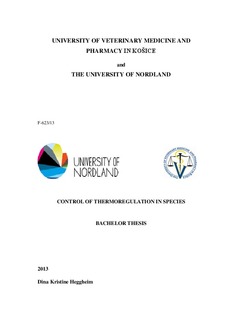| dc.description.abstract | Thermoregulation is a concept that refers to the process of regulating the body temperature in such a way that it is kept in a relatively constant range. This is very important, regarding the many chemical processes that happens in the body at any given time.
The thermoregulatory strategies in the world is many and diverse. The main division is between ectotherms and endotherms. Endotherm animals include mammals and birds. These animals have a higher metabolic rate than the ectotherms. This is because the metabolic processes produce heat, and the endotherms can regulate their body temperature by regulating the metabolic rate. The increased metabolic rate in endotherms means that their way of thermoregulating have a greater energy cost than the ectotherms strategy.
Heat transfer between the animal and the environment is happening through the four very distinct mechanisms: conduction, convection, radiation and evaporation. Conduction is the transfer of heat through a solid or a fluid, without movement. Convection is heat transfer through a medium that moves, for instance, fluid in flow is an example of heat transfer via convection. Radiation happens between the animal and the environment. Energy that is absorbed is converted into heat at the surface of the object. The animal will emit heat through radiation. The main mechanisms for heat loss include evaporative heat loss and non-evaporative heat loss. Evaporative heat loss happens through evaporation of sweat, or panting and gular fluttering etc. while non-evaporative heat loss happens through changes in insulation and piloerection, or through posture changes.
Shivering is a thermoregulatory response found in homeotherm animals. The response is rather remarkable, and involve the skeletal muscle performing rapid, repeated contractions. These contractions leads to heat production. The non-shivering thermogenesis include brown fat as a mechanism for thermoregulatory heat production.
In ectotherms, the autonomic mechanisms of thermoregulation seen in endotherms is lacking. However, the ectotherms do display some control over the body temperature by selecting thermal microhabitats that are appropriate for them. This behavior causes a body temperature that is stable under varying ambient temperatures. It is termed behavioural thermoregulation.
If the body temperature rises, and the animal is not able to compensate with its thermoregulatory mechanisms, it will lead to hyperthermia. If the body temperature decreases and the animal is not able to compensate, it will lead to hypothermia. | no_NO |
